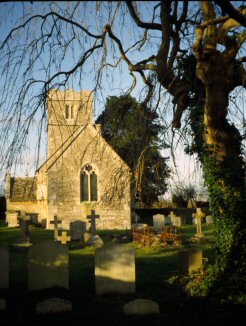| Tellisford is a village four miles north-east of Frome that inspired
the author Arthur Mee to write “We do not remember a more charming place
in all our journeyings”; what held good when those words were written
in the 1930s remains good today. Two hundred years ago Tellisford consisted
of 23 houses and had a population of 120 people – today this has risen
to 26 houses and 140 people. The village is located on the River Frome and
the medieval Pack Horse Bridge is most certainly worth a visit. The Environment
Agency maintain a monitoring station here close to the old Weir and Tellisford
Mill is in the process of being upgraded to produce electrical power using
a German made water turbine capable of producing enough electricity to power
the whole village.
The Parish Church of All Saints dates back to the 12th Century and is built
of stone quarried in Doulting – the same source as that used for Wells
Cathedral. Three Tellisford Parishioners went to the Great War of 1914-1918
and all three returned to this, one of the smallest of Somerset’s
‘Thankful Villages’. |

All Saints, Tellisford, Photo - Terry Brown |
